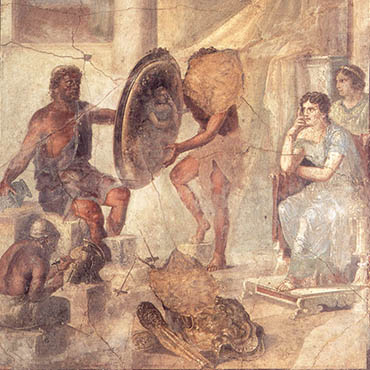4. Optics and perspective

Optics in ancient times developed according to two leading schools of thought: one stating that vision was derived from images impressed on the eye, and the other maintaining instead that the eye emitted beams of light that struck objects.
Based on this second hypothesis, Euclid proposed a geometric model of the mechanics of sight, which has remained substantially unchanged even today.
The Romans considered both the science that studied the refraction of rays in dense bodies, known as dioptrics, and catoptrics--the study of rays reflected from shiny surfaces, such as mirrors--to be part of optics. Applications deriving from the study of optics included the application of the laws of vision to architecture and the figurative arts.
In the ancient world there were two opposing theories of optics: one maintained that images were emitted from bodies, while the second held that rays of vision exited from the eyes and hit the surfaces of objects. Departing from this second hypothesis, Euclid elaborated on a geometric method for applying the laws of optics to measuring distances.
Classical optics was articulated in two fields: dioptrics, which studies phenomena of refraction, like rainbows and burning glass lenses; and catoptrics, which is concerned with phenomena of reflection, like the formation of images on flat, curved, and polyhedral mirrors.
From catoptrics were derived various applications, both entertainment and military, like the theatre glasses of Heron, the burning glass mirrors of Archimedes, and the legendary telescopes of the Pharos of Alexandria and the Colossus of Rhodes. From catoptrics also emerged the various practices of reading the future from images reflected on shields or in a silver cup.
Beginning in the fifth century BC, the laws of vision were applied to architecture and the figurative arts. These laws were derived from a segment of optics called scenography. Adopting a series of optical techniques, which Vitruvius also described, architects and sculptors attempted to render their work visually harmonious.
The laws of perspective representation were also a part of scenography, and were derived from the decoration of Hellenistic theatres. According to Vitruvius, the rules consisted of defining the centre of the depiction, corresponding to the eye of the spectator, and all lines of the depiction had to converge on this point. From the theatrical tradition were also derived the architectural perspectives of Roman painting which decorated the great villas of Pompeii, from the Villa of Mysteries to the Villa of Boscoreale to the Villa of Poppeia at Oplontis.
According to modern rules of perspective, lines originating in the distance converge toward a vanishing point corresponding to the eye of the observer. The line of the horizon also passes through this point. The distance point, which regulates the convergence of lines oriented at 45 degrees, is also found on the line of the horizon. The intersection of these lines and those converging in the vanishing point indicate the positioning of parallel lines in the scene. The Pompeian perspective regarding these rules are only for the convergence of the lines originating in the distance. Rarely is an entire composition governed by a single vanishing point; more often it returns to various vanishing points, situated at different heights on the central axis.
It is not possible, on the other hand, to discern whether the ancient Romans knew of the use of the distance point. We presume, from the consistent frontal perspective of Pompeian painting, that the painters created at first an elevation drawing, subsequently developing perspective through the projection from the centre of all its points towards the foreground and background.

